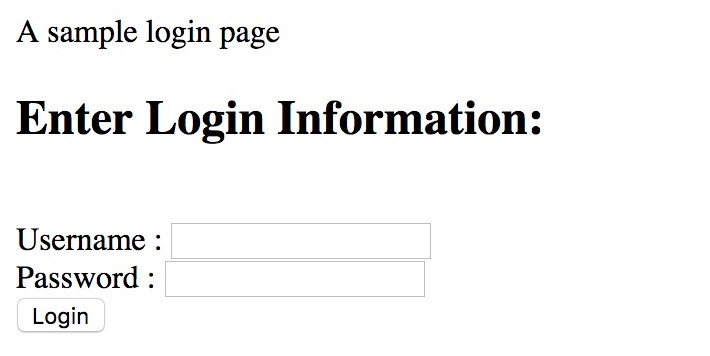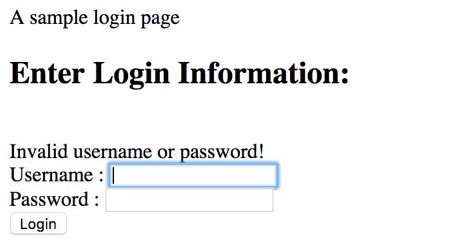Login Page in PHP
It will be seldom found that an engaging website doesn’t propose an account creation from its customers. In order to do so, they need to have the facilities for a new user to register themselves, and later on login and interact with the website using their account. PHP exposes enough utilities to set up a functional Login Page, quickly, which can also scale later on as when required. After setting up a basic login form to request the credentials, the same PHP script can be used to process and validate the credentials, and redirect to the appropriate page on successful login. It also provides options for creating and storing cookies and sessions, to track users once they have completed the login process.
ADVERTISEMENT Popular Course in this category PHP DEVELOPER - Specialization | 8 Course Series | 3 Mock TestsStart Your Free Software Development Course
Web development, programming languages, Software testing & others
How do Login Pages Work in PHP?
PHP is a scalable stateless server-side scripting language. It allows one to capture form data by storing them in arrays $_GET or $_POST depending on whether the method used while submitting the form is GET or POST. Generally, the post method is preferred due to security reasons. Upon submission, these arrays can be indexed by the input field names to get the specific value.
For login forms, the credentials are passed and stored in these arrays, which more often than not, is just a set of usernames and passwords. Based on the requirement, either the username & password combination can be directly validated in the PHP code itself, or the valid set of username, password combinations might be stored in a database which could be looked up.
Setting up the Login Page
Let’s create a page, Login.php containing the following HTML lines:
Code:
<html> <head>A sample login page</head> <body> <h2>Enter Login Information:</h2><br> <form action="" method="post"> <label>Username : </label><input type="text" name="username" /><br/> <label>Password : </label><input type="password" name="pwd" /><br/> <input type="submit" value="Login" /> </form> </body> </html>
Output:

These lines create a very simple form, requiring a user to enter two fields, a username, and a password. It provides a third input, which is a submit button and causes form data, i.e. username and password, be sent to the location mentioned in the action attribute of the form tag. Since it’s empty above, it passes the form information to the same PHP page.
How to Create a Login Page in PHP?
The above page is static HTML code, without actually validating the user or login the person to internal web-pages. In order to do so, we need to process the values passed in the fields username and pwd stored in $_POST because of the method posts.
Thus the values are present can be checked using:
Code:
<?php
$error = "";
if(isset($_POST['username']) && isset($_POST['pwd'])){
// check for validity
}
?>Upon verifying at both inputs are indeed present, we can validate their values and redirect a person to the appropriate welcome page.
We can achieve this by inserting following simple piece of code within the if-statement block shown above:
Code:
$username = $_POST['username'];
$password = $_POST['pwd'];
if($username == "admin" && $password == "l0G3In"){
header('location: Home.php');
}
else {
$error = "Invalid username or password!";
}With the above lines, once the user has submitted a valid set of credentials, he’s allowed access to home.php, or we store an error message which can be shown to the user.
Session
We don’t want a user to repeatedly login in upon every request. Thus we need to keep track of users who have logged in, irrespective of the page they are requesting. One way of achieving this in PHP is using sessions.
Briefly, sessions are a server-side small piece of information, temporarily stored for a client, once the page is requested. In PHP this is achieved by calling function session_start() as the first line in the script. From next time the page is accessed, session_start() doesn’t create a new session but retrieves information of the session started earlier and stores in a special array $_SESSION.
Values to be passed across pages while a session is active can be set in a similar fashion to a normal array and isset() function can be used to check if a particular value is available within the array.
Combining all the things discussed, the code will look as follows:
Code:
A sample login pageEnter Login Information:
Output:

Home.php
Now, any other page which requires a login just needs to check that the session key login is set. If not, the user can be redirected to the login page. Else he has access to the secret internal content.
Let’s create one for demo purposes:
Code:
<?php
session_start();
if(!isset($_SESSION["login"]) || $_SESSION["login"]!=True){
header('location: Login.php');
}
?>
<html>
<head>Welcome to User's Home Page</head>
<body>
<h2>Wishing you a good day!!</h2><br>
</body>
</html>Output:

The above code first retrieves the session details by invoking session_start(). It then validates that the session is still active for a user who had completed the login process. If not, the user is sent to the Login.php page. If the user had successfully logged in, the rest of the content is available to the user.
Conclusion
It’s extremely easy to create login pages in PHP. Here we have directly stored the credentials in the script, but ideally (and most commonly) they will be stored in some form of a database or key manager. Also, here we used sessions, which are stored on the browser side, but you can use cookies that are stored on the browser (client) side but are less reliable.
The above is the detailed content of Login Page in PHP. For more information, please follow other related articles on the PHP Chinese website!

Hot AI Tools

Undresser.AI Undress
AI-powered app for creating realistic nude photos

AI Clothes Remover
Online AI tool for removing clothes from photos.

Undress AI Tool
Undress images for free

Clothoff.io
AI clothes remover

Video Face Swap
Swap faces in any video effortlessly with our completely free AI face swap tool!

Hot Article

Hot Tools

Notepad++7.3.1
Easy-to-use and free code editor

SublimeText3 Chinese version
Chinese version, very easy to use

Zend Studio 13.0.1
Powerful PHP integrated development environment

Dreamweaver CS6
Visual web development tools

SublimeText3 Mac version
God-level code editing software (SublimeText3)

Hot Topics
 1664
1664
 14
14
 1421
1421
 52
52
 1316
1316
 25
25
 1266
1266
 29
29
 1239
1239
 24
24
 Explain JSON Web Tokens (JWT) and their use case in PHP APIs.
Apr 05, 2025 am 12:04 AM
Explain JSON Web Tokens (JWT) and their use case in PHP APIs.
Apr 05, 2025 am 12:04 AM
JWT is an open standard based on JSON, used to securely transmit information between parties, mainly for identity authentication and information exchange. 1. JWT consists of three parts: Header, Payload and Signature. 2. The working principle of JWT includes three steps: generating JWT, verifying JWT and parsing Payload. 3. When using JWT for authentication in PHP, JWT can be generated and verified, and user role and permission information can be included in advanced usage. 4. Common errors include signature verification failure, token expiration, and payload oversized. Debugging skills include using debugging tools and logging. 5. Performance optimization and best practices include using appropriate signature algorithms, setting validity periods reasonably,
 Explain late static binding in PHP (static::).
Apr 03, 2025 am 12:04 AM
Explain late static binding in PHP (static::).
Apr 03, 2025 am 12:04 AM
Static binding (static::) implements late static binding (LSB) in PHP, allowing calling classes to be referenced in static contexts rather than defining classes. 1) The parsing process is performed at runtime, 2) Look up the call class in the inheritance relationship, 3) It may bring performance overhead.
 PHP Program to Count Vowels in a String
Feb 07, 2025 pm 12:12 PM
PHP Program to Count Vowels in a String
Feb 07, 2025 pm 12:12 PM
A string is a sequence of characters, including letters, numbers, and symbols. This tutorial will learn how to calculate the number of vowels in a given string in PHP using different methods. The vowels in English are a, e, i, o, u, and they can be uppercase or lowercase. What is a vowel? Vowels are alphabetic characters that represent a specific pronunciation. There are five vowels in English, including uppercase and lowercase: a, e, i, o, u Example 1 Input: String = "Tutorialspoint" Output: 6 explain The vowels in the string "Tutorialspoint" are u, o, i, a, o, i. There are 6 yuan in total
 What are PHP magic methods (__construct, __destruct, __call, __get, __set, etc.) and provide use cases?
Apr 03, 2025 am 12:03 AM
What are PHP magic methods (__construct, __destruct, __call, __get, __set, etc.) and provide use cases?
Apr 03, 2025 am 12:03 AM
What are the magic methods of PHP? PHP's magic methods include: 1.\_\_construct, used to initialize objects; 2.\_\_destruct, used to clean up resources; 3.\_\_call, handle non-existent method calls; 4.\_\_get, implement dynamic attribute access; 5.\_\_set, implement dynamic attribute settings. These methods are automatically called in certain situations, improving code flexibility and efficiency.
 PHP and Python: Comparing Two Popular Programming Languages
Apr 14, 2025 am 12:13 AM
PHP and Python: Comparing Two Popular Programming Languages
Apr 14, 2025 am 12:13 AM
PHP and Python each have their own advantages, and choose according to project requirements. 1.PHP is suitable for web development, especially for rapid development and maintenance of websites. 2. Python is suitable for data science, machine learning and artificial intelligence, with concise syntax and suitable for beginners.
 PHP in Action: Real-World Examples and Applications
Apr 14, 2025 am 12:19 AM
PHP in Action: Real-World Examples and Applications
Apr 14, 2025 am 12:19 AM
PHP is widely used in e-commerce, content management systems and API development. 1) E-commerce: used for shopping cart function and payment processing. 2) Content management system: used for dynamic content generation and user management. 3) API development: used for RESTful API development and API security. Through performance optimization and best practices, the efficiency and maintainability of PHP applications are improved.
 PHP: A Key Language for Web Development
Apr 13, 2025 am 12:08 AM
PHP: A Key Language for Web Development
Apr 13, 2025 am 12:08 AM
PHP is a scripting language widely used on the server side, especially suitable for web development. 1.PHP can embed HTML, process HTTP requests and responses, and supports a variety of databases. 2.PHP is used to generate dynamic web content, process form data, access databases, etc., with strong community support and open source resources. 3. PHP is an interpreted language, and the execution process includes lexical analysis, grammatical analysis, compilation and execution. 4.PHP can be combined with MySQL for advanced applications such as user registration systems. 5. When debugging PHP, you can use functions such as error_reporting() and var_dump(). 6. Optimize PHP code to use caching mechanisms, optimize database queries and use built-in functions. 7
 Explain the match expression (PHP 8 ) and how it differs from switch.
Apr 06, 2025 am 12:03 AM
Explain the match expression (PHP 8 ) and how it differs from switch.
Apr 06, 2025 am 12:03 AM
In PHP8, match expressions are a new control structure that returns different results based on the value of the expression. 1) It is similar to a switch statement, but returns a value instead of an execution statement block. 2) The match expression is strictly compared (===), which improves security. 3) It avoids possible break omissions in switch statements and enhances the simplicity and readability of the code.




